Solar eclipse of August 22, 1979
An annular solar eclipse occurred at the Moon's ascending node of the orbit on Wednesday, August 22, 1979. A solar eclipse occurs when the Moon passes between Earth and the Sun, thereby totally or partly obscuring the image of the Sun for a viewer on Earth. An annular solar eclipse occurs when the Moon's apparent diameter is smaller than the Sun's, blocking most of the Sun's light and causing the Sun to look like an annulus (ring). An annular eclipse appears as a partial eclipse over a region of the Earth thousands of kilometres wide. A small annular eclipse covered only 93% of the Sun in a very broad path, 953 km wide at maximum, and lasted 6 minutes and 3 seconds. This was the second solar eclipse in 1979, the first one a total solar eclipse on February 26.
| Solar eclipse of August 22, 1979 | |
|---|---|
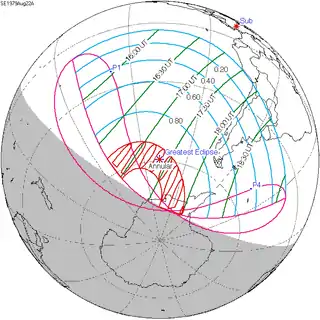 Map | |
| Type of eclipse | |
| Nature | Annular |
| Gamma | −0.9632 |
| Magnitude | 0.9329 |
| Maximum eclipse | |
| Duration | 363 sec (6 m 3 s) |
| Coordinates | 59.6°S 108.5°W |
| Max. width of band | 953 km (592 mi) |
| Times (UTC) | |
| Greatest eclipse | 17:22:38 |
| References | |
| Saros | 125 (52 of 73) |
| Catalog # (SE5000) | 9463 |
This was the last of 40 umbral eclipses of Solar Saros 125. The first was in 1276 and the last was in 1979. The total duration is 703 years.
Related eclipses
Eclipses in 1979
- A total solar eclipse on Monday, 26 February 1979.
- A partial lunar eclipse on Tuesday, 13 March 1979.
- An annular solar eclipse on Wednesday, 22 August 1979.
- A total lunar eclipse on Thursday, 6 September 1979.
Solar eclipses 1979–1982
Each member in a semester series of solar eclipses repeats approximately every 177 days and 4 hours (a semester) at alternating nodes of the Moon's orbit.
| Solar eclipse series sets from 1979 to 1982 | ||||||
|---|---|---|---|---|---|---|
| Descending node | Ascending node | |||||
| Saros | Map | Saros | Map | |||
| 120 |  1979 February 26 Total |
125 |  1979 August 22 Annular | |||
| 130 |  1980 February 16 Total |
135 | 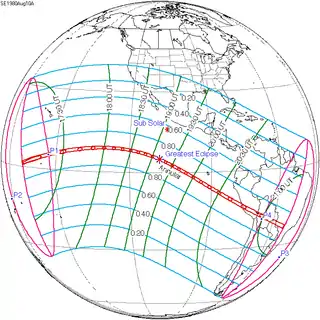 1980 August 10 Annular | |||
| 140 |  1981 February 4 Annular |
145 |  1981 July 31 Total | |||
| 150 |  1982 January 25 Partial |
155 |  1982 July 20 Partial | |||
| Partial solar eclipses on June 21, 1982 and December 15, 1982 occur in the next lunar year eclipse set. | ||||||
Saros 125
Solar saros 125, repeating every about 18 years and 11 days, contains 73 events. The series started with a partial solar eclipse on February 4, 1060. It has total eclipses from June 13, 1276, to July 16, 1330. It has hybrid eclipses on July 26, 1348, and August 7, 1366, and annular eclipses from August 17, 1384, to August 22, 1979. The series ends at member 73 as a partial eclipse on April 9, 2358. The longest total eclipse occurred on June 25, 1294, at 1 minute and 11 seconds; the longest annular eclipse occurred on July 10, 1907, at 7 minutes and 23 seconds.[1]
| Series members 47–58 occur between 1881 and 2100: | ||
|---|---|---|
| 47 | 48 | 49 |
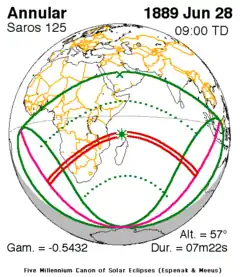 June 28, 1889 |
 July 10, 1907 |
 July 20, 1925 |
| 50 | 51 | 52 |
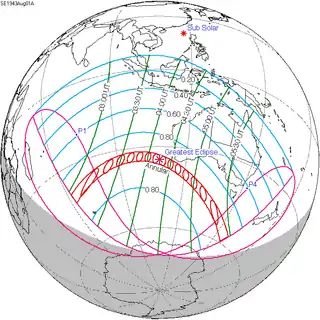 August 1, 1943 |
 August 11, 1961 |
 August 22, 1979 |
| 53 | 54 | 55 |
 September 2, 1997 |
 September 13, 2015 |
 September 23, 2033 |
| 56 | 57 | 58 |
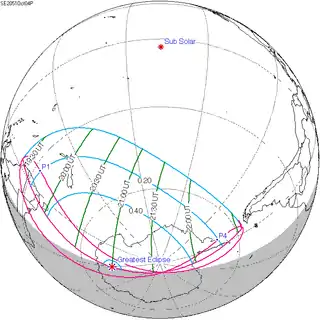 October 4, 2051 |
 October 15, 2069 |
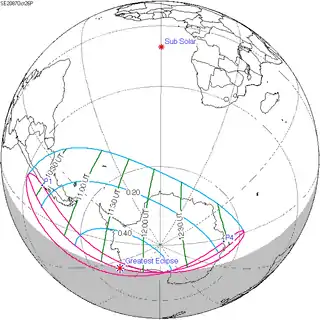 October 26, 2087 |
Tritos series
This eclipse is a part of a tritos cycle, repeating at alternating nodes every 135 synodic months (≈ 3986.63 days, or 11 years minus 1 month). Their appearance and longitude are irregular due to a lack of synchronization with the anomalistic month (period of perigee), but groupings of 3 tritos cycles (≈ 33 years minus 3 months) come close (≈ 434.044 anomalistic months), so eclipses are similar in these groupings.
| Series members between 1901 and 2100 | |||
|---|---|---|---|
 March 29, 1903 (Saros 118) |
 February 25, 1914 (Saros 119) |
 January 24, 1925 (Saros 120) | |
 December 25, 1935 (Saros 121) |
 November 23, 1946 (Saros 122) |
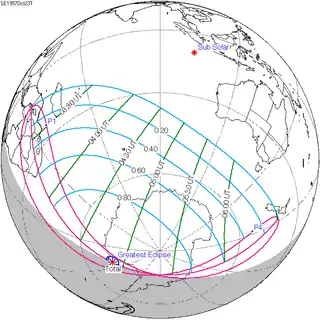 October 23, 1957 (Saros 123) | |
 September 22, 1968 (Saros 124) |
 August 22, 1979 (Saros 125) |
 July 22, 1990 (Saros 126) | |
 June 21, 2001 (Saros 127) |
 May 20, 2012 (Saros 128) |
 April 20, 2023 (Saros 129) | |
 March 20, 2034 (Saros 130) |
 February 16, 2045 (Saros 131) |
 January 16, 2056 (Saros 132) | |
 December 17, 2066 (Saros 133) |
 November 15, 2077 (Saros 134) |
 October 14, 2088 (Saros 135) | |
 September 14, 2099 (Saros 136) |
|||
Metonic series
The metonic series repeats eclipses every 19 years (6939.69 days), lasting about 5 cycles. Eclipses occur in nearly the same calendar date. In addition, the octon subseries repeats 1/5 of that or every 3.8 years (1387.94 days). All eclipses in this table occur at the Moon's ascending node.
| 21 eclipse events, progressing from south to north between June 10, 1964, and August 21, 2036 | ||||
|---|---|---|---|---|
| June 10–11 | March 27–29 | January 15–16 | November 3 | August 21–22 |
| 117 | 119 | 121 | 123 | 125 |
 June 10, 1964 |
 March 28, 1968 |
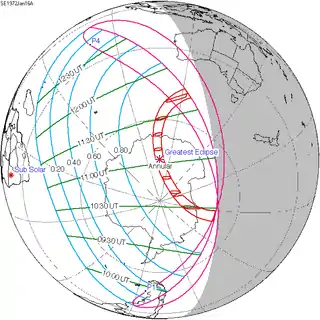 January 16, 1972 |
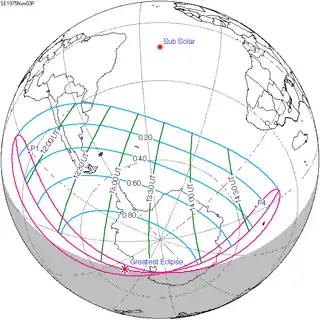 November 3, 1975 |
 August 22, 1979 |
| 127 | 129 | 131 | 133 | 135 |
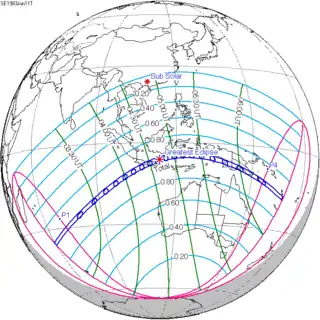 June 11, 1983 |
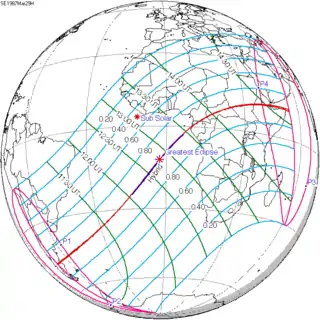 March 29, 1987 |
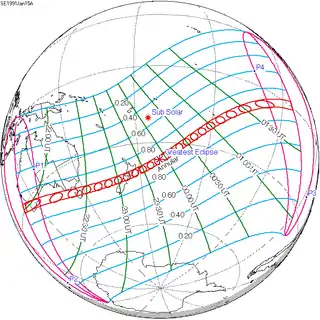 January 15, 1991 |
 November 3, 1994 |
 August 22, 1998 |
| 137 | 139 | 141 | 143 | 145 |
 June 10, 2002 |
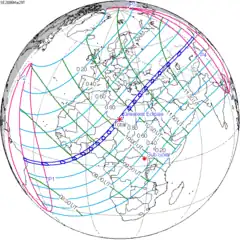 March 29, 2006 |
 January 15, 2010 |
 November 3, 2013 |
 August 21, 2017 |
| 147 | 149 | 151 | 153 | 155 |
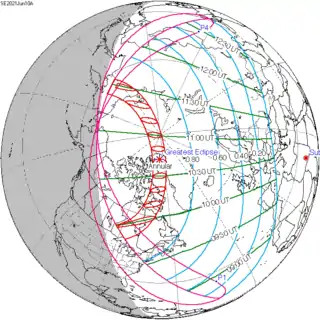 June 10, 2021 |
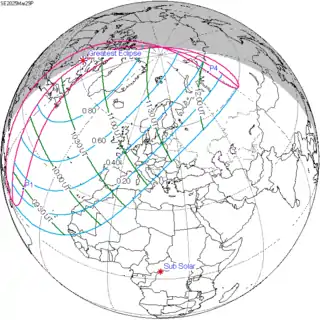 March 29, 2025 |
 January 14, 2029 |
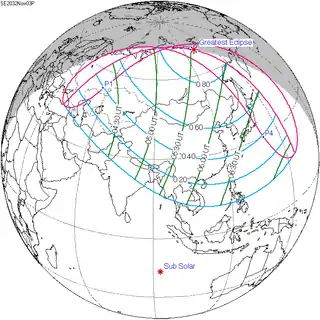 November 3, 2032 |
 August 21, 2036 |
Notes
- Saros Series Catalog of Solar Eclipses NASA Eclipse Web Site.
References
- Earth visibility chart and eclipse statistics Eclipse Predictions by Fred Espenak, NASA/GSFC
.jpg.webp)

